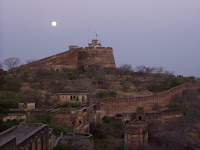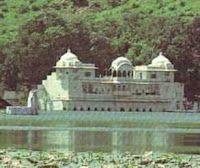
Bundi is well known for its palaces, forts, Baori (stepwells) and water tanks and thus it is also known as "town of wells" because of large no. of stepwells located here. Bundi is famous for its monuments and especially its fort which preserves the legacy of its glorious past. Historical monument, including havelis, temples, stone umbrellas with carved pillars, dams and ponds, forests, wildlife, fairs and festivals. Bundi is very famous for its intricate sculptures and murals. Monuments and their architecture reflect the splendor of the glory of its leaders.
Bundi is situated at the foot of a large hill surrounded by the Aravalli hills on three sides with a lake inside the city. Bundi is loved by tourists for its serene atmosphere and picturesque scenery.

It is located 35 km from Kota and 210 km from Jaipur. Bundi is located at 25.44 ° N 75.64 ° E [1] and an average altitude of 268 meters (879 feet).
History
History of Bundi brings you to notice the zeitgeist of brave Rajputs of Rajasthan. Bundi was once the capital of Rajasthan. The magnificent architectural monuments of Bundi still reflect the brilliance of ancient local Rajput chiefs. The walls and ceiling of the palaces of Bundi are decorated with frescoes, the Bundi School of paintings that depict the glory of its leaders.
In the ancient era, Bundi was obviously inhabited by local tribes of which the Parihar Meenas were prominent. It is believed that Bundi is named after an ancient king called Bunda Meena. Bundi was called "Bunda-Ka-Nal", Nal meaning "narrow ways ". Then after this region was ruled by Rao Deva Hada, in A.D. 1342, he took the possession of Bundi from Jaita Meena. The Hadoti region in which Bundi stands has taken its name Hadoti from these Hada Rajputs. At one point, the state of Bundi is judged by Hadas includes contemporary districts of Bundi, Kota, Baran and Jhalawar. Later two separate states Kota and Bundi Hadas formed by Hadas on both sides of the river Chambal.
Taragarh Fort – Bundi

Taragarh Fort or 'Star Fort' was built in 1354 by Rao Bar Singh. Fort is situated on steep hill at the height of 500 meters. Lakshmi Pol, Gagudi ki Phatak and Phuta Darwaza are the three gateways to the fort and has massive battlements and ramparts. Bhim Burj is the largest of its battlements is the 16th century. Taragarh Fort is also known for its tunnels crisscrossing the entire hillside. Water reservoirs were built inside the fort to store and supply water. A small palace was built inside fort for wives and concubines of rulers known as Rani Mahal (Queen Palace). The fort welcomes the tourists through a huge gateway. Tourists can see the entire town from the fort. Tourists also love to visit the fort to see sunset.
Bundi Palace

The Bundi Palace, built adjacent to the fort is a living examples of finest Rajput architecture. Bundi Palace is a showcase of extraordinary craftsmanship and reflects the glorious era of the Indian royalty. A beautiful gigantic wooden gate would lead to the entrance of Bundi Palace. The attraction of Bundi palace is traditional murals and most of the parts of palace walls are decorated with the murals. These murals show the travellers a glimpse of the royal lifestyle of the rulers of Bundi. Hathi Pol, Diwan-I-Am and the Naubat khana are the palace of special attraction inside the bundi palace. Chitrashala is also located inside the palace that reflects the colorful glimpse of the Indian history, most of the wall and ceilings are covered with the paintings of the loyal time.
Sukh Mahal

The Sukh Mahal a magnificent palace is built on the wall of Jait Sagar lake with a beautiful garden called Sar Bagh and the hills around the palace. This outstanding royal palace is a fine example of Rajput architecture, Sukh Mahal is a magnificent summer palace on the Jait Sagar lake with beautiful garden surrounded by hills. Rudyard Kipling once came and stayed in this beautiful spacious palace.
Chitrashala

Chitrashala is also situated adjacent to the Palace. The famous Chitrashala, built by Rao Raja Umed Singh (1739-70) is also known as the Ummed Mahal. Chitrashala has a separate entrance with a beautiful garden. The walls and ceilings of the Chitra Shala are painted with beautiful paintings of Raas Leela, Radha Krishna, paintings of hunting and court scenes, festivals and lifestyle of rulers. These beautiful paintings are the example of finest art of Bundi school of paintings.
Eighty Four Pillared Cenotaph

An incredibly beautiful memorial with 84 pillars in a single cenotaph. It was erected by Rao Anirudh in memory of his foster brother. It was a magnificent memorial built in 1740. It is a place of worship of Lord Shiva and a well-maintained beautiful garden at the entrance of cenotaph.
Phool Sagar
Phool Mahal or Flower Palace is located at the west of Bundi. This charming Phool Sagar Palace is the 20th century palace with an artificial reservoir and picturesque gardens. This is also an example of excellent and well-planned architecture. It was the residence of the former ruler. Permission of Secretary is required to see this palace.
Jait Sagar Lake

A beautiful man made nestled among the hills build by Jaita Meena. The fleeting fountain in the night. Sukh Mahal, Terrace gardens and Smriti Kunj are the other attractions of the lake.
Chhattar Mahal
A steep, paved path carriage is the only way to reach the monument. Special interest in the palace is the "Hazari Pole 'or' Gate of the thousand", the Naubat Khana, the Hathi Pole with its old water clock and Diwaane-e-Aam.
Nawal Sagar

Nawal Sagar lake is a artificial lake located inside the city. The reflection of the city and its palaces can be seen in the lake - making it a unique attraction of Bundi. It is a point of attraction with the entrance of the city through highway. A cenotaph is situated at the centre of the lake and a temple dedicated to Varuna, the God of Water stands half submerged in the lake.
Ranlji-Ki-Baori

Bundi is known for its beauty of different types of step wells, a visit to the township of Bundi is recommended. There are a number of step wells in the city out of those worth a mention are Naval Sagar, Sisodiaji ki Baori, Purushottam ki Baori, Sukhi Baori, Manoharji ki Baori and Rani ji ki Baori.
Rani ji ki Baori is 46 m deep stepped well with some superb carvings on its pillars and an arched gate built in 1699 AD by Rani Nathavatji.